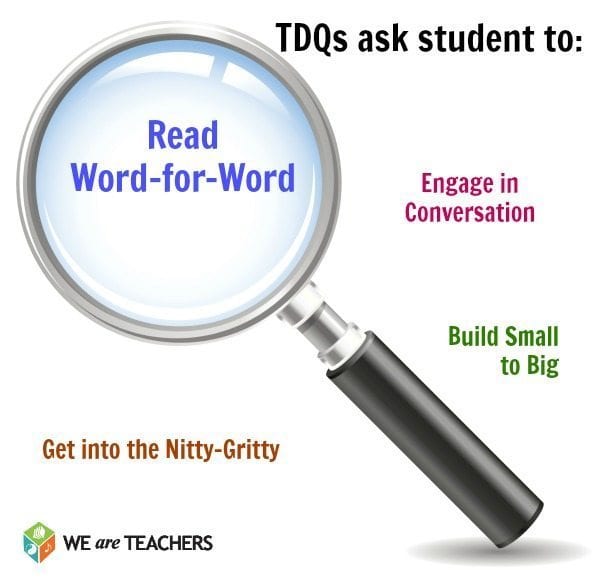Questions are at the core of close reading. What you ask and when you ask it shapes how students experience text. In particular, the Common Core has brought text-dependent questions to the forefront. Standards at each grade level require that students analyze the text. As a result, text-dependent questions or TDQs are all the rage. In this, the first of a three-post series about TDQs, I’ll discuss what TDQs are and how they’re different than other types of questions.
TDQs are questions that can only be answered by returning to the text. Students shouldn’t be able to (exclusively) use their background knowledge or information outside the text to answer them.
For example, if we were to do a close reading of the first few pages of M. C. Higgins the Great by Virginia Hamilton, we could ask students:
- What is your favorite time of day and why?
- How does your setting impact you? Or, how does a character’s setting, impact them?
- Think about a choice you made recently, how much of it was in your control? In general, how much of our lives are within our control?
All of these questions, while not TDQs, relate to the book and can be helpful. Non-TDQs can activate background knowledge, help students develop ideas and opinions before reading, and start or elaborate conversation. But, without building close reading around TDQs, you won’t be confident about students’ ability to understand and use the text.
So, what makes for strong TDQs? Questions that require students to pause and ponder specific paragraphs, sentences, words, and phrases. TDQs ask students to:
- Read Word-for-Word: To be clear, TDQs don’t require students to read entire passages word-by-word, instead they point them to specific sections of text that students delve into and analyze word-by-word or sentence-by-sentence.
- Engage in Conversation: When questions ask about author’s choices, alternatives, and about what was unsaid or said in a text, they’re requiring students to consider the text from an objective stance, which deepens understanding.
- Build from Small to Big: Series of TDQs should look at individual arguments, ideas, and details, then help students understand how those small parts build to a whole.
- Get into the Nitty-Gritty: TDQs help students delve into the fine details of structure—how authors change direction, opinions, or present multiple ideas, and how these moves impact the reader.
 Back to M. C. Higgins the Great:
Back to M. C. Higgins the Great:
- Why does M. C. like the early morning so much?
- What do we learn about the setting? How might the setting impact M. C.?
- At this point in the story, what options does M. C. have? How much is in his control?
These questions refer students to specific lines or paragraphs in the text and set up similar conversations to the non-TDQs, but with the expectation that students are grounded in the text.
When TDQs are used effectively, they help readers discover ideas that they hadn’t seen before, or on their own. How have you used TDQs in your class already? What have you learned?
Next Up: Writing Strong (or Stronger) TDQs
